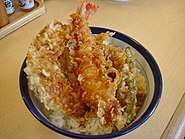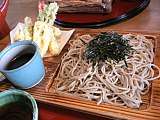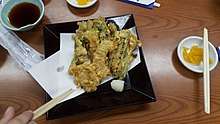Tempura
Tempura (天ぷら or 天麩羅, tenpura, [tempɯɾa]) is a typical Japanese dish usually consisting of seafood, meat, and vegetables that have been battered and deep fried. The dish was introduced by the Portuguese residing in Nagasaki through the fritter-cooking techniques in the 16th century. The name "tempura" originates from the Latin phrase quatuor anni tempora, which refers to the Ember Days, during which no meat is consumed.[1]
Preparation
Batter
A light batter is made of iced water (sometimes sparkling water is used to keep the batter light)[2] and soft wheat flour (cake, pastry or all-purpose flour).[3][4][5] Eggs (especially egg yolk), baking soda or baking powder, starch, oil, and/or spices may also be added. Tempura batter is traditionally mixed in small batches using chopsticks for only a few seconds, leaving lumps in the mixture that, along with the cold batter temperature, result in the unique fluffy and crisp tempura structure when cooked. The batter is often kept cold by adding ice, or by placing the bowl inside a larger bowl with ice in it. Overmixing the batter will result in activation of wheat gluten, which causes the flour mixture to become soft and dough-like when fried.
Specially formulated tempura flour is available in worldwide supermarkets. This is generally light (low-gluten) flour, and occasionally contains leaveners such as baking powder.
Tempura generally does not use breadcrumbs (panko) in the coating. Generally, fried foods which are coated with breadcrumbs are considered to be furai, Japanese-invented Western-style deep fried foods, such as tonkatsu or ebi furai (fried prawn).
Frying
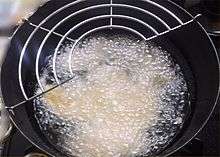
Thin slices or strips of vegetables or seafood are dipped in the batter, then briefly deep-fried in hot oil. Vegetable oil or canola oil are most common; however, tempura was traditionally cooked using sesame oil.[6] Many specialty shops still use sesame oil or tea seed oil, and it is thought certain compounds in these oils help to produce light, crispier batter.
The bits of batter (known as tenkasu) are scooped out between batches of tempura, so they do not burn and leave a bad flavor in the oil. A small mesh scoop (Ami jakushi) is used for this purpose. Tenkasu are often reserved as ingredients in other dishes or as a topping.
Ingredients
Various seafood and vegetables are commonly used as the ingredients in traditional tempura.
Seafood

The most popular seafood tempura is probably ebi (shrimp) tempura. Types of seafood used in tempura includes:
- prawn
- shrimp
- squid
- scallop
- crab
- ayu (sweetfish)
- anago (conger eel)
- fish
- Catfish
- white fish
- cod
- haddock
- pollock
- coley
- plaice
- skate
- ray
- Huss (Various fish species including Galeorhinus, Mustelus, Scyliorhinus, Galeus melastomus, Squalus acanthias – also known as Spiny dogfish or "Rock salmon")
- rock salmon (a term covering several species of dogfish and similar fish)
- whiting
- Japanese whiting
- Sea bass
- Sea perch
Vegetables
.jpg)
Vegetables tempura is called yasai tempura. The all vegetable tempura might be served as a vegetarian dish. Types of vegetables includes:
- bamboo shoots
- bell pepper
- broccoli
- butternut squash
- carrot
- eggplant
- gobo (burdock, Arctium lappa)
- ginger
- green beans
- kabocha
- mushrooms
- okra
- onion
- pumpkin
- potato
- renkon (lotus root)
- seaweed
- shiitake mushroom
- shiso leaf
- sweet potato
- yam
Serving and presentation

Cooked bits of tempura are either eaten with dipping sauce, salted without sauce, or used to assemble other dishes. Tempura is commonly served with grated daikon and eaten hot immediately after frying. In Japan, it is often found in bowls of soba or udon soup often in the form of a shrimp, shiso leaf, or fritter. The most common sauce is tentsuyu sauce (roughly three parts dashi, one part mirin, and one part shōyu). Alternatively, skim tempura may be sprinkled with sea salt before eating. Mixtures of powdered green tea and salt or yuzu and salt are also used.
Kakiage is a type of tempura made with mixed vegetable strips, such as onion, carrot, and burdock, and sometimes including shrimp or squid, which are deep fried as small round fritters.
Tempura is also used in combination with other foods. When served over soba (buckwheat noodles), it is called tempura soba[7] or tensoba. Tempura is also served as a donburi dish where tempura shrimp and vegetables are served over steamed rice in a bowl (tendon) and on top of udon soup (tempura udon).
History
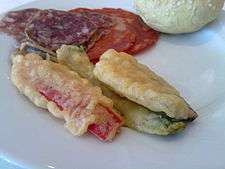
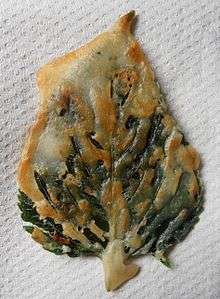
.jpg)
Origins
Earlier Japanese deep-fried food was either simply fried without breading or batter, or fried with rice flour. However, toward the end of the 16th century, fritter-cooking with a batter of flour and eggs was acquired in Nagasaki from Portuguese missionaries and merchants from the region of Alentejo. It was a way to fulfill the fasting and abstinence rules for Catholics surrounding the quarterly ember days (Latin: Quattuor Tempora). Hence the etymology of the word. In those days, tempura was deep-fried in lard with a batter of flour, water, eggs, and salt; unlike today, it was eaten without dipping sauce.
In the early 17th century, around the Tokyo Bay area, tempura ingredients and preparation underwent a remarkable change as the Yatai (food cart) culture gained popularity. Making the best use of fresh seafood while preserving its delicate taste, tempura used only flour, eggs and water as ingredients and the batter was not flavored. As the batter was mixed minimally in cold water, it avoided the dough-like stickiness caused by the activation of wheat gluten, resulting in the crispy texture which is now characteristic of tempura. It became customary to dip tempura quickly in a sauce mixed with grated daikon just before eating it.
Today in Japan the mainstream of tempura recipes originate from "Tokyo style (Edo style)" tempura, which was invented at the food stalls along the riverside fish market in the Edo period. The main reason tempura became popular was the abundance of seafood. In addition, as oil extraction techniques advanced, cooking oil became cheaper. Serving of deep-fried food indoors was prohibited during Edo because tempura oil was a fire hazard in Japanese building, which were made of paper and wood. For that reason, tempura gained popularity as fast food eaten at outdoor food stalls. It was skewered and eaten with a dipping sauce. Tempura is considered one of "the Edo Delicacies" along with soba (buckwheat noodles) and sushi which were also food-stall take-outs.
The modern tempura recipe was first published in 1671 in the cook book called "料理献立抄". After the Meiji period, tempura was no longer considered a fast food item but instead developed as a high-class cuisine.
Etymology
| Look up tempura in Wiktionary, the free dictionary. |
The word "tempura", or the technique of dipping fish and vegetables into a batter and frying them, comes from the word "tempora", a Latin word meaning "times", "time period" used by both Spanish and Portuguese missionaries to refer to the Lenten period or Ember Days (ad tempora quadragesima), Fridays, and other Christian holy days. Ember Days, or quatuor anni tempora in Latin, refer to holy days when Catholics avoid red meat and instead eat fish or vegetables.[9] The idea that the word "tempura" may have been derived from the Portuguese noun tempero, meaning a condiment or seasoning of any kind, or from the verb temperar, meaning "to season" is also possible as the Japanese language could easily have assumed the word "tempero" as is, without changing any vowels as the Portuguese pronunciation in this case is similar to the Japanese.[10] There is still today a dish in Portugal very similar to tempura called peixinhos da horta, "garden fishes", which consists of green beans dipped in a batter and fried.
The term "tempura" is thought to have gained popularity in southern Japan; it became widely used to refer to any sort of food prepared using hot oil, including some already existing Japanese foods. Today, and particularly in western Japan, the word "tempura" is also commonly used to refer to satsuma-age, fried surimi fish cake which is made without batter.[11][12]
Variations
Japan
In Japan, restaurants specializing in tempura are called tenpura-ya. Many restaurants offer tempura as part of a set meal or a bento (lunch box), and it is also a popular ingredient in take-out or convenience store bento boxes. The ingredients and styles of cooking and serving tempura vary greatly through the country, with importance being placed on using fresh, seasonal ingredients.
Outside Japan
.jpg)
Outside Japan (as well as recently in Japan), there are many nontraditional and fusion uses of tempura. Chefs over the world include tempura dishes on their menus, and a wide variety of different batters and ingredients are used, including the nontraditional broccoli, zucchini, asparagus and chuchu. More unusual ingredients may include nori slices, dry fruit such as banana, and ice cream (tempura-based fried ice cream). American restaurants are known to serve tempura in the form of various meats, particularly chicken, and cheeses, usually mozzarella. A variation is to use panko (breadcrumbs), which results in a crisper consistency than tempura batter. Using panko in Japan would no longer qualify the dish as tempura. It would become something else called fry or pronounced in Japanese as furai. Tempura (particularly shrimp) is often used as a filling in makizushi. A more recent variation of tempura sushi has entire pieces of sushi being dipped in batter and tempura-fried.
In Bangladesh the blossoms of pumpkins or marrows are often deep fried with a gram of rice flour spice mix creating a Bengali style tempura known as kumro ful bhaja.
Taiwan
In Taiwan, tempura as described in the preceding is known as tiānfùluó (天婦羅) and can commonly be found on the menu in Japanese restaurants all over the island. A similar-sounding dish, tianbula (Chinese: 甜不辣; pinyin: tiánbùlà; lit.: 'sweet, not spicy') is usually sold at night markets. Tianbula is actually Japanese satsuma-age and was introduced to Taiwan under Japanese rule by people from Kyushu, where satsuma-age is commonly known as tempura.[13][11][12]
See also
- Karaage; a Japanese cooking technique, similar to tempura, in which various foods—-most often chicken, but also other meat and fish—-are deep fried in oil.
- Kushikatsu; a Japanese dish of deep-fried skewered meat and vegetables.
- Tonkatsu; a Japanese deep fried pork cutlet
- Karakudamono; a Japanese term used to collectively describe assorted pastry confections of Chinese origin (also called togashi).
- Pakora, a South Asian food resembling tempura
- Okoy, Filipino shrimp fritters
- Camaron rebosado, Filipino deep fried battered shrimp
- Schnitzel, European fried crumbed meat
References
| Wikibooks Cookbook has a recipe/module on |
| Wikimedia Commons has media related to Tempura. |
- BBC Travel - The truth about Japanese tempura
- fishcooking.about.com
- Okamoto, Osamu (1994). Sam Okamoto's incredible vegetables. Pelican Publishing Company. p. 31. ISBN 1-56554-025-5.
- Meyer, Arthur L.; Vann, Jon M. (2003). The Appetizer Atlas: A World of Small Bites. John Wiley and Sons. p. 235. ISBN 0-471-41102-7.
- Kobayashi, Katsuyo (2000). The quick and easy Japanese cookbook: great recipes from Japan's favorite TV cooking show host. Kodansha International. p. 23. ISBN 4-7700-2504-1.
- Frank, Dr Sandra (2017-01-07). "Dietitians Online Blog: January 7, National Tempura Day – Tempura Tofu and Spring Vegetables". Dietitians Online Blog. Retrieved 2017-01-25.
- "Tempura Soba". Authentic Recipe List. Asian Inspiretion. Retrieved 6 November 2015.
- "Fukagawa Edo Museum".
- Narloch, Leandro (2013). "Samurais". Guia Politicamente Incorreto da História do Mundo (in Portuguese) (1 ed.). São Paulo: Editora Leya. p. 163. ISBN 9788580448405.
- "Japanese Writers' House Newsletter". 2007-10-10. Retrieved 2008-01-11.
- Ishige, Naomichi (2014). The History and Culture of Japanese Food. Routledge. p. 246. ISBN 1136602550.
- "「さつま揚げ」の各都道府県での呼び名を調査 関西は「天ぷら」". J-TOWN.NET. June 16, 2017. Retrieved March 23, 2020.
- Katakura, Yoshifumi (2016). "片倉佳史の台湾歴史紀行 第一回 港湾都市・基隆を訪ねる" (PDF). Japan–Taiwan Exchange Association. p. 9. Retrieved March 23, 2020.
